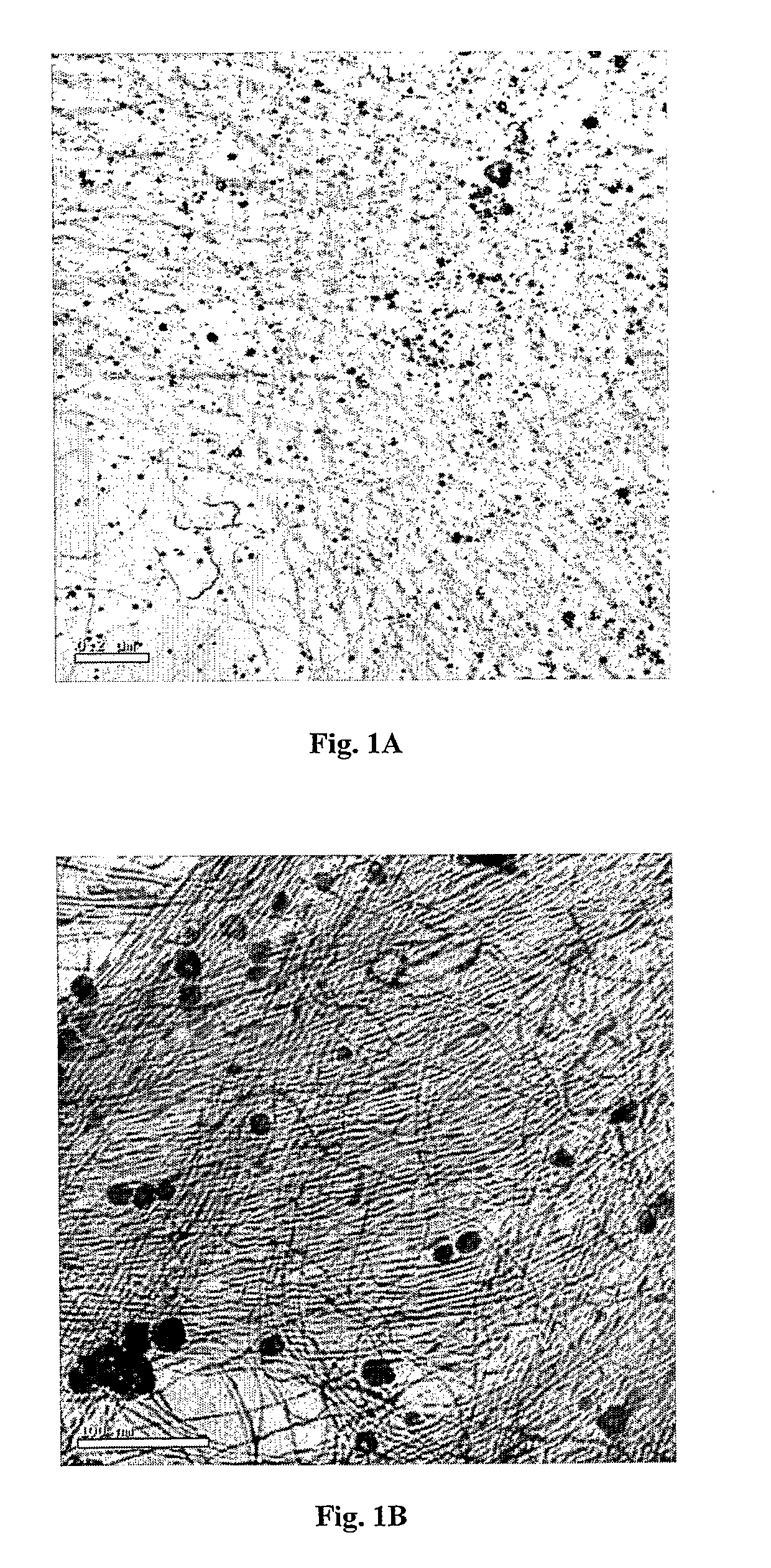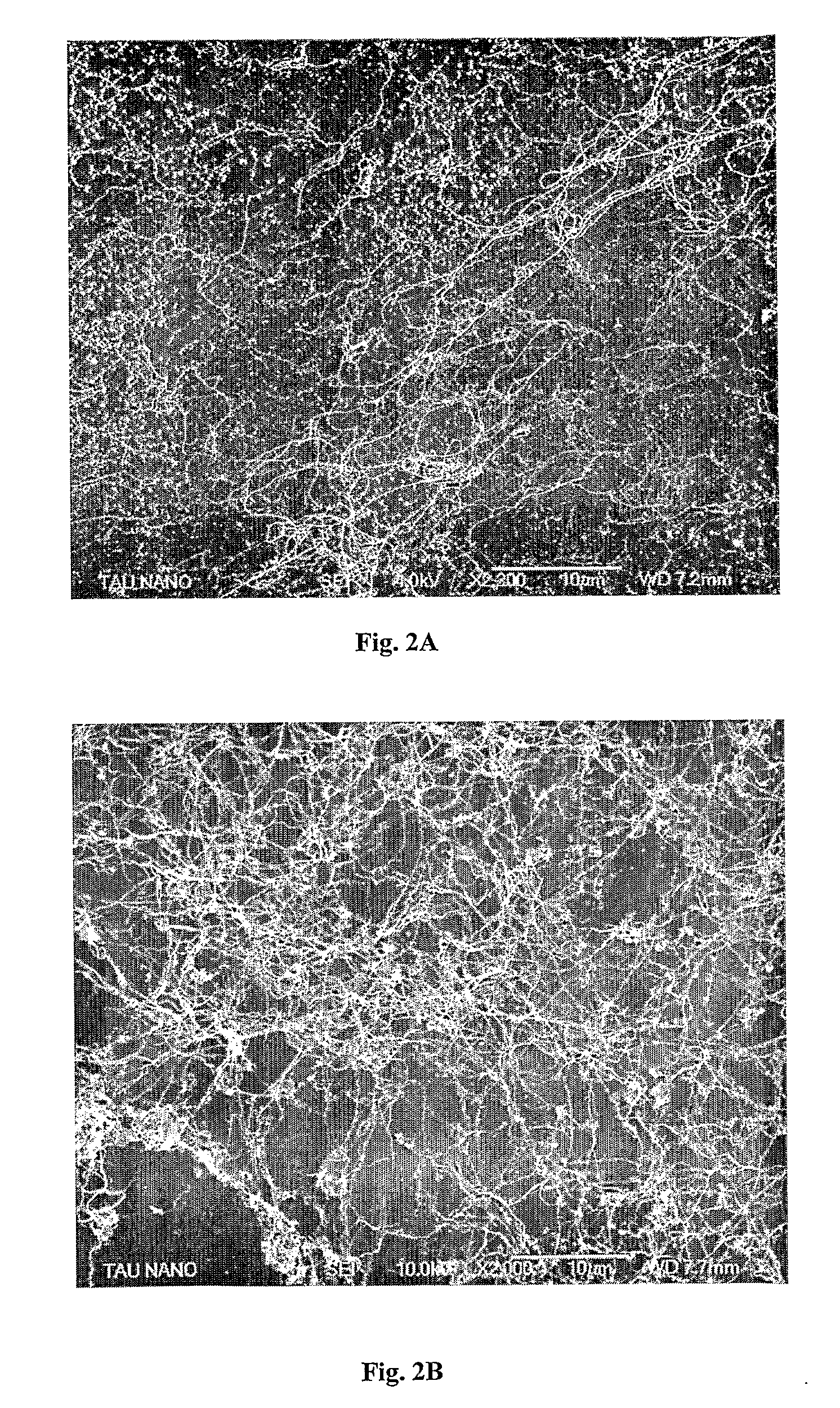Metal nanowire thin-films
a metal nanowire and thin film technology, applied in the direction of dielectric characteristics, liquid/solution decomposition chemical coating, conductors, etc., can solve the problems of limited transparency/conductivity trade-off between film and film, hard and brittle films, expensive vacuum deposition techniques, etc., to enhance the characteristics of nanowire films
- Summary
- Abstract
- Description
- Claims
- Application Information
AI Technical Summary
Benefits of technology
Problems solved by technology
Method used
Image
Examples
example 1
[0154]A 8.3% (w / w) cetyltrimethylammonium bromide (CTAB) solution was prepared by heating and stirring the CTAB / water mixture at 50?C for 5 minutes. To this solution, at 40?C, 500 μL of 25 mM HAuCl4 solution and 425 μL of 1.8 M freshly prepared sodium ascorbate solution were added and stirred together. Then, 250 μL of 100 mM AgNO3 solution were added while stirring. The final CTAB concentration in the nanowire growth solution was ˜7.5%. 30 seconds after the addition of the Ag solution, the stirring was discontinued and the solution was deposited on a substrate and let dry for 15-45 minutes at 35-40° C.
[0155]Transmission electron microscopy (TEM) and scanning electron microscopy (SEM) imaging revealed metal nanowire networks of varying wire densities and entanglement, depending on the exact solution and deposition conditions, uniformly spread over the substrates (FIGS. 1 and 2). The nanowires were typically 3-5 nm wide and many micrometers long and in this case composed of 85-90% gol...
example 2
[0160]A solution comprising surfactant cetyltrimethylammonium bromide (CTAB), chloroauric acid, as a gold precursor at a molar ratio of 1:200 relative to the CTAB concentration, and sodium ascorbate, at a molar ratio of 60:1 relative to the gold concentration, was prepared. The nanowire growth solutions had CTAB concentrations of 0.25 M and 0.6 M, significantly higher than the 0.1 M used by Murphy [1,2]. In addition, the growth solution contained a relatively high concentration of silver nitrate, twice the concentration of the Au(III) ions. When the four components were mixed together at 35?C the gold ions were reduced to the colorless Au(I) state, forming a [AuX2]−-CTA+ comply (X═Cl, Br) but further reduction to the metallic state required the addition of catalytic metal seed particles. Similarly, the silver ions formed an AgBr-CTAB complex.
[0161]As an alternative, a small amount of sodium borohydride dissolved in water (e.g., 0.001-0.0001%) was added to the precursor solution in o...
example 3
[0169]As recited above, in some experiments, prior to the addition of the reducing agent (e.g., sodium ascorbate) to the Au precursor solution, the silver solution was added to the Au precursor solution and only then the mild reducing agent e.g., sodium ascorbate was added. Under such conditions no metal reduction was induced. Subsequently, low concentration (e.g., 1 / 100 of that of the sodium ascorbate or lower) of a stronger reducing agent with respect to ascorbate was added to the solution. Such stronger reducing agent should have a reduction potential)(E0) of −0.5 V or more negative. Non-limiting examples are sodium borohydride, sodium cyanoborohydride and hydrazine. The addition of the strong reducing agent initiated metal reduction in this solution and subsequent metal deposition on the substrate.
PUM
| Property | Measurement | Unit |
|---|---|---|
| Fraction | aaaaa | aaaaa |
| Fraction | aaaaa | aaaaa |
| Time | aaaaa | aaaaa |
Abstract
Description
Claims
Application Information
 Login to View More
Login to View More - R&D
- Intellectual Property
- Life Sciences
- Materials
- Tech Scout
- Unparalleled Data Quality
- Higher Quality Content
- 60% Fewer Hallucinations
Browse by: Latest US Patents, China's latest patents, Technical Efficacy Thesaurus, Application Domain, Technology Topic, Popular Technical Reports.
© 2025 PatSnap. All rights reserved.Legal|Privacy policy|Modern Slavery Act Transparency Statement|Sitemap|About US| Contact US: help@patsnap.com



